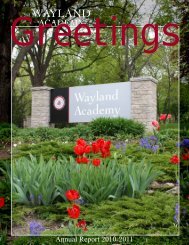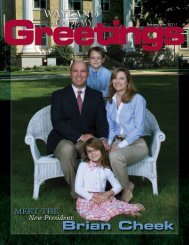Greetings XCI #2 - Wayland Academy
Greetings XCI #2 - Wayland Academy
Greetings XCI #2 - Wayland Academy
Create successful ePaper yourself
Turn your PDF publications into a flip-book with our unique Google optimized e-Paper software.
Terrill has a reputation for being one<br />
of the most interesting people to speak<br />
to on campus. Conversation with Mr.<br />
Knaack rarely dissolves into the<br />
standard platitudes but always seems<br />
to end up engaging with art and the<br />
natural world in new or unusual ways.<br />
The <strong>Greetings</strong> staff sat down with Mr.<br />
Knaack for an interview in his Sunny<br />
Point Studio on Beaver Dam Lake.<br />
<strong>Greetings</strong>: How important is<br />
communication in your art classes?<br />
TK: You’d be surprised. There have<br />
been some students that have come to<br />
<strong>Wayland</strong> from other schools where<br />
they’ve had art, and they expect that<br />
they’re going to sit in a corner and not<br />
participate in class.<br />
<strong>Greetings</strong>: So you would posit<br />
communication as prior to<br />
representation?<br />
TK: Well, art as a form of<br />
communication is a more holistic form<br />
of communication than perhaps other<br />
things. It encompasses a certain<br />
analytical cerebral aspect, it’s<br />
emotional, and it’s visceral: it has an<br />
instinctive aspect to it. And some art is<br />
stronger, in each of those three ways<br />
than others, but you see this in<br />
students, too. When you have a<br />
student in art class for a couple of<br />
weeks, you notice that some of them<br />
are much more emotionally centered,<br />
some of them are more<br />
instinctive/visceral, some of them are<br />
real analytical, logical. They look at a<br />
painting, and they start analyzing it. So<br />
the ideal is to build on that (we use<br />
this term holistic or integrative) to find<br />
a relationship between the other basic<br />
intelligences that a human being has.<br />
We are three-centered or three-brained<br />
beings.<br />
Not only visual art does that, but also<br />
poetry does that beautifully. Poetry<br />
goes right along with the visual arts<br />
and so does music. As a matter of fact,<br />
a lot of what I teach is in analogies<br />
with music because it is very, very<br />
similar. All art boils down to the study<br />
of form at some point or another.<br />
That’s what we teach: a sensitivity to<br />
the interrelationship of form.<br />
<strong>Greetings</strong>: When I look at your<br />
paintings, I’ve always been struck by<br />
how well you represent nature. You<br />
have a real insight and talent at doing<br />
what most people today rely on<br />
photographs to do.<br />
TK: A very important aspect of my<br />
work is that it’s done from observation<br />
and not photographs. I’ve always been<br />
interested in photography and a lot of<br />
my education was with some great<br />
photographers. I studied with Minor<br />
White at MIT and knew a lot of the<br />
classical great fine-art photographers<br />
back in the 70’s. So I’ve always had an<br />
interest in large format photography<br />
and wanted to make that part of my life.<br />
But I wanted to show that the<br />
relationship between a camera, the<br />
man behind the camera, and the<br />
subject, is very different from the<br />
relationship of what I’m doing when<br />
I’m out sketching in nature. That<br />
relationship with the subject and the<br />
way I’m capturing it is quite a bit<br />
different. There are certain parallels,<br />
but with the camera, the medium of<br />
photography is basically just light, as I<br />
see it. I’m just interested in what light<br />
is communicating<br />
to me. And what I<br />
find so fascinating<br />
about taking<br />
pictures is that<br />
pictures find you.<br />
Light finds you, in<br />
a certain way, and<br />
that picks up your<br />
attention. If you<br />
follow your<br />
attention through,<br />
the thing will<br />
speak to you and<br />
tell you how to do<br />
it. That’s the way<br />
I experience it.<br />
Morning in May<br />
<strong>Greetings</strong>: Have you had moments<br />
when painting in which you realize<br />
you’ve done something in the<br />
representation of the object that could<br />
not have been done by a photograph?<br />
TK: Oh yeah, absolutely (gestures to<br />
prints). What you’re looking at here<br />
are mostly reproductions of the<br />
artwork. They’re all reduced. A<br />
reproduction is not ideal, it’s not the<br />
work itself. It’s a real reality of being<br />
an artist, though, because most people<br />
aren’t going to spend the money that<br />
you’re going to get for original art.<br />
And so you try to do as well as you<br />
can with a reproduction to make them<br />
long term collectible items if you can.<br />
These are all pigmented, all done on<br />
canvas and extremely expensive to do,<br />
actually. And these will last for<br />
hundreds of years, just like the original<br />
art will, but they are not the real thing.<br />
Let’s take a look at one of the paintings<br />
here: (Walking to original “Morning in<br />
May”)<br />
TK: You see the pigment? You see the<br />
brush strokes? None of that has<br />
anything to do with photographic<br />
representation. I do have my plein aire<br />
paintings. There are some of my studio<br />
paintings, especially some of my earlier<br />
paintings that are more tightly done.<br />
Everything I’m doing now is really<br />
strong on conveying the spirit of the<br />
paintings through the brushstroke.<br />
www.wayland.org 3<br />
ALUMNI ARTISTS








